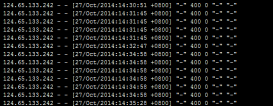nginx源碼分析線程池詳解
一、前言
nginx是采用多進程模型,master和worker之間主要通過pipe管道的方式進行通信,多進程的優勢就在于各個進程互不影響。但是經常會有人問道,nginx為什么不采用多線程模型(這個除了之前一篇文章講到的情況,別的只有去問作者了,HAHA)。其實,nginx代碼中提供了一個thread_pool(線程池)的核心模塊來處理多任務的。下面就本人對該thread_pool這個模塊的理解來跟大家做些分享(文中錯誤、不足還請大家指出,謝謝)
二、thread_pool線程池模塊介紹
nginx的主要功能都是由一個個模塊構成的,thread_pool也不例外。線程池主要用于讀取、發送文件等IO操作,避免慢速IO影響worker的正常運行。先引用一段官方的配置示例
|
1
2
3
|
Syntax: thread_pool name threads=number [max_queue=number];Default: thread_pool default threads=32 max_queue=65536;Context: main |
根據上述的配置說明,thread_pool是有名字的,上面的線程數目以及隊列大小都是指每個worker進程中的線程,而不是所有worker中線程的總數。一個線程池中所有的線程共享一個隊列,隊列中的最大人數數量為上面定義的max_queue,如果隊列滿了的話,再往隊列中添加任務就會報錯。
根據之前講到過的模塊初始化流程(在master啟動worker之前) create_conf--> command_set函數-->init_conf,下面就按照這個流程看看thread_pool模塊的初始化
|
1
2
3
4
5
6
7
8
9
10
11
12
13
14
15
16
17
18
19
20
21
22
23
24
25
26
27
28
29
30
31
32
33
34
35
36
37
38
39
40
41
42
43
44
45
46
47
48
49
50
51
52
53
54
55
56
57
58
59
60
61
62
63
64
65
66
|
/******************* nginx/src/core/ngx_thread_pool.c ************************///創建線程池所需的基礎結構static void * ngx_thread_pool_create_conf(ngx_cycle_t *cycle){ ngx_thread_pool_conf_t *tcf; //從cycle->pool指向的內存池中申請一塊內存 tcf = ngx_pcalloc(cycle->pool, sizeof(ngx_thread_pool_conf_t)); if (tcf == NULL) { return NULL; } //先申請包含4個ngx_thread_pool_t指針類型元素的數組 //ngx_thread_pool_t結構體中保存了一個線程池相關的信息 if (ngx_array_init(&tcf->pools, cycle->pool, 4, sizeof(ngx_thread_pool_t *)) != NGX_OK) { return NULL; } return tcf;} //解析處理配置文件中thread_pool的配置,并將相關信息保存的ngx_thread_pool_t中static char * ngx_thread_pool(ngx_conf_t *cf, ngx_command_t *cmd, void *conf){ ngx_str_t *value; ngx_uint_t i; ngx_thread_pool_t *tp; value = cf->args->elts; //根據thread_pool配置中的name作為線程池的唯一標識(如果重名,只有第一個有效) //申請ngx_thread_pool_t結構保存線程池的相關信息 //由此可見,nginx支持配置多個name不同的線程池 tp = ngx_thread_pool_add(cf, &value[1]); ....... //處理thread_pool配置行的所有元素 for (i = 2; i < cf->args->nelts; i++) { //檢查配置的線程數 if (ngx_strncmp(value[i].data, "threads=", 8) == 0) { ....... } //檢查配置的最大隊列長度 if (ngx_strncmp(value[i].data, "max_queue=", 10) == 0) { ....... } } ......} //判斷包含多個線程池的數組中的各個線程池的配置是否正確static char * ngx_thread_pool_init_conf(ngx_cycle_t *cycle, void *conf){ .... ngx_thread_pool_t **tpp; tpp = tcf->pools.elts; //遍歷數組中所有的線程池配置,并檢查其正確性 for (i = 0; i < tcf->pools.nelts; i++) { ..... } return NGX_CONF_OK;} |
在上述的流程走完之后,nginx的master就保存了一份所有線程池的配置(tcf->pools),這份配置在創建worker時也會被繼承。然后每個worker中都調用各個核心模塊的init_process函數(如果有的話)。
|
1
2
3
4
5
6
7
8
9
10
11
12
13
14
15
16
17
18
19
20
21
22
23
24
25
26
27
28
29
30
31
32
33
34
35
36
37
38
39
40
41
42
43
44
45
46
47
48
49
50
51
52
53
54
55
56
57
58
59
60
61
62
63
64
65
66
67
68
69
70
71
72
73
74
75
76
77
78
79
80
81
82
83
84
85
86
87
88
89
90
91
92
93
94
95
96
97
98
99
100
101
102
103
104
105
106
107
108
109
110
111
112
113
114
115
116
117
118
119
120
121
122
123
124
125
126
127
128
129
130
131
132
133
134
135
136
137
138
139
140
141
142
|
/******************* nginx/src/core/ngx_thread_pool.c ************************///創建線程池所需的基礎結構static ngx_int_tngx_thread_pool_init_worker(ngx_cycle_t *cycle){ ngx_uint_t i; ngx_thread_pool_t **tpp; ngx_thread_pool_conf_t *tcf; //如果不是worker或者只有一個worker就不起用線程池 if (ngx_process != NGX_PROCESS_WORKER && ngx_process != NGX_PROCESS_SINGLE) { return NGX_OK; } //初始化任務隊列 ngx_thread_pool_queue_init(&ngx_thread_pool_done); tpp = tcf->pools.elts; for (i = 0; i < tcf->pools.nelts; i++) { //初始化各個線程池 if (ngx_thread_pool_init(tpp[i], cycle->log, cycle->pool) != NGX_OK) { return NGX_ERROR; } } return NGX_OK;} //線程池初始化static ngx_int_t ngx_thread_pool_init(ngx_thread_pool_t *tp, ngx_log_t *log, ngx_pool_t *pool){ ..... //初始化任務隊列 ngx_thread_pool_queue_init(&tp->queue); //創建線程鎖 if (ngx_thread_mutex_create(&tp->mtx, log) != NGX_OK) { return NGX_ERROR; } //創建線程條件變量 if (ngx_thread_cond_create(&tp->cond, log) != NGX_OK) { (void) ngx_thread_mutex_destroy(&tp->mtx, log); return NGX_ERROR; } ...... for (n = 0; n < tp->threads; n++) { //創建線程池中的每個線程 err = pthread_create(&tid, &attr, ngx_thread_pool_cycle, tp); if (err) { ngx_log_error(NGX_LOG_ALERT, log, err, "pthread_create() failed"); return NGX_ERROR; } } ......} //線程池中線程處理主函數static void *ngx_thread_pool_cycle(void *data){ ...... for ( ;; ) { //阻塞的方式獲取線程鎖 if (ngx_thread_mutex_lock(&tp->mtx, tp->log) != NGX_OK) { return NULL; } /* the number may become negative */ tp->waiting--; //如果任務隊列為空,就cond_wait阻塞等待有新任務時調用cond_signal/broadcast觸發 while (tp->queue.first == NULL) { if (ngx_thread_cond_wait(&tp->cond, &tp->mtx, tp->log) != NGX_OK) { (void) ngx_thread_mutex_unlock(&tp->mtx, tp->log); return NULL; } } //從任務隊列中獲取task,并將其從隊列中移除 task = tp->queue.first; tp->queue.first = task->next; if (tp->queue.first == NULL) { tp->queue.last = &tp->queue.first; } if (ngx_thread_mutex_unlock(&tp->mtx, tp->log) != NGX_OK) { return NULL; } ...... //task的處理函數 task->handler(task->ctx, tp->log); ..... ngx_spinlock(&ngx_thread_pool_done_lock, 1, 2048); //將經過預處理的任務添加到done隊列中等待調用event的回調函數繼續處理 *ngx_thread_pool_done.last = task; ngx_thread_pool_done.last = &task->next; //防止編譯器優化,保證解鎖操作是在上述語句執行完畢后再去執行的 ngx_memory_barrier(); ngx_unlock(&ngx_thread_pool_done_lock); (void) ngx_notify(ngx_thread_pool_handler); }} //處理pool_done隊列上task中包含的每個event事件static void ngx_thread_pool_handler(ngx_event_t *ev){ ..... ngx_spinlock(&ngx_thread_pool_done_lock, 1, 2048); //獲取任務鏈表的頭部 task = ngx_thread_pool_done.first; ngx_thread_pool_done.first = NULL; ngx_thread_pool_done.last = &ngx_thread_pool_done.first; ngx_memory_barrier(); ngx_unlock(&ngx_thread_pool_done_lock); while (task) { ngx_log_debug1(NGX_LOG_DEBUG_CORE, ev->log, 0, "run completion handler for task #%ui", task->id); //遍歷隊列中的所有任務事件 event = &task->event; task = task->next; event->complete = 1; event->active = 0; //調用event對應的處理函數有針對性的進行處理 event->handler(event); }} |
三、thread_pool線程池使用示例
根據之前所講到的,nginx中的線程池主要是用于操作文件的IO操作。所以,在nginx中自帶的模塊ngx_http_file_cache.c文件中看到了線程池的使用。
|
1
2
3
4
5
6
7
8
9
10
11
12
13
14
15
16
17
18
19
20
21
22
23
24
25
26
27
28
29
30
31
32
33
34
35
36
37
38
39
40
41
42
43
44
45
46
47
48
49
50
51
52
53
54
55
56
57
58
59
60
61
62
63
64
65
66
67
68
69
70
71
72
73
74
75
76
77
78
79
80
81
82
83
84
85
86
87
88
89
90
91
92
93
|
/*********************** nginx/src/os/unix/ngx_files.c **********************///file_cache模塊的處理函數(涉及到了線程池)static ssize_t ngx_http_file_cache_aio_read(ngx_http_request_t *r, ngx_http_cache_t *c){ .......#if (NGX_THREADS) if (clcf->aio == NGX_HTTP_AIO_THREADS) { c->file.thread_task = c->thread_task; //這里注冊的函數在下面語句中的ngx_thread_read函數中被調用 c->file.thread_handler = ngx_http_cache_thread_handler; c->file.thread_ctx = r; //根據任務的屬性,選擇正確的線程池,并初始化task結構體中的各個成員 n = ngx_thread_read(&c->file, c->buf->pos, c->body_start, 0, r->pool); c->thread_task = c->file.thread_task; c->reading = (n == NGX_AGAIN); return n; }#endif return ngx_read_file(&c->file, c->buf->pos, c->body_start, 0);} //task任務的處理函數static ngx_int_t ngx_http_cache_thread_handler(ngx_thread_task_t *task, ngx_file_t *file){ ....... tp = clcf->thread_pool; ....... task->event.data = r; //注冊thread_event_handler函數,該函數在處理pool_done隊列中event事件時被調用 task->event.handler = ngx_http_cache_thread_event_handler; //將任務放到線程池的任務隊列中 if (ngx_thread_task_post(tp, task) != NGX_OK) { return NGX_ERROR; } ......} /*********************** nginx/src/core/ngx_thread_pool.c **********************///添加任務到隊列中ngx_int_t ngx_thread_task_post(ngx_thread_pool_t *tp, ngx_thread_task_t *task){ //如果當前的任務正在處理就退出 if (task->event.active) { ngx_log_error(NGX_LOG_ALERT, tp->log, 0, "task #%ui already active", task->id); return NGX_ERROR; } if (ngx_thread_mutex_lock(&tp->mtx, tp->log) != NGX_OK) { return NGX_ERROR; } //判斷當前線程池等待的任務數量與最大隊列長度的關系 if (tp->waiting >= tp->max_queue) { (void) ngx_thread_mutex_unlock(&tp->mtx, tp->log); ngx_log_error(NGX_LOG_ERR, tp->log, 0, "thread pool \"%V\" queue overflow: %i tasks waiting", &tp->name, tp->waiting); return NGX_ERROR; } //激活任務 task->event.active = 1; task->id = ngx_thread_pool_task_id++; task->next = NULL; //通知阻塞的線程有新事件加入,可以解除阻塞 if (ngx_thread_cond_signal(&tp->cond, tp->log) != NGX_OK) { (void) ngx_thread_mutex_unlock(&tp->mtx, tp->log); return NGX_ERROR; } *tp->queue.last = task; tp->queue.last = &task->next; tp->waiting++; (void) ngx_thread_mutex_unlock(&tp->mtx, tp->log); ngx_log_debug2(NGX_LOG_DEBUG_CORE, tp->log, 0, "task #%ui added to thread pool \"%V\"", task->id, &tp->name); return NGX_OK;} |
上面示例基本展示了nginx目前對線程池的使用方法,采用線程池來處理IO這類慢速操作可以提升worker的主線程的執行效率。當然,用戶自己在開發模塊時,也可以參照file_cache模塊中使用線程池的方法來調用多線程提升程序性能。(歡迎大家多多批評指正)
感謝閱讀,希望能幫助到大家,謝謝大家對本站的支持!
原文鏈接:http://www.cnblogs.com/sxhlinux/p/6906490.html















